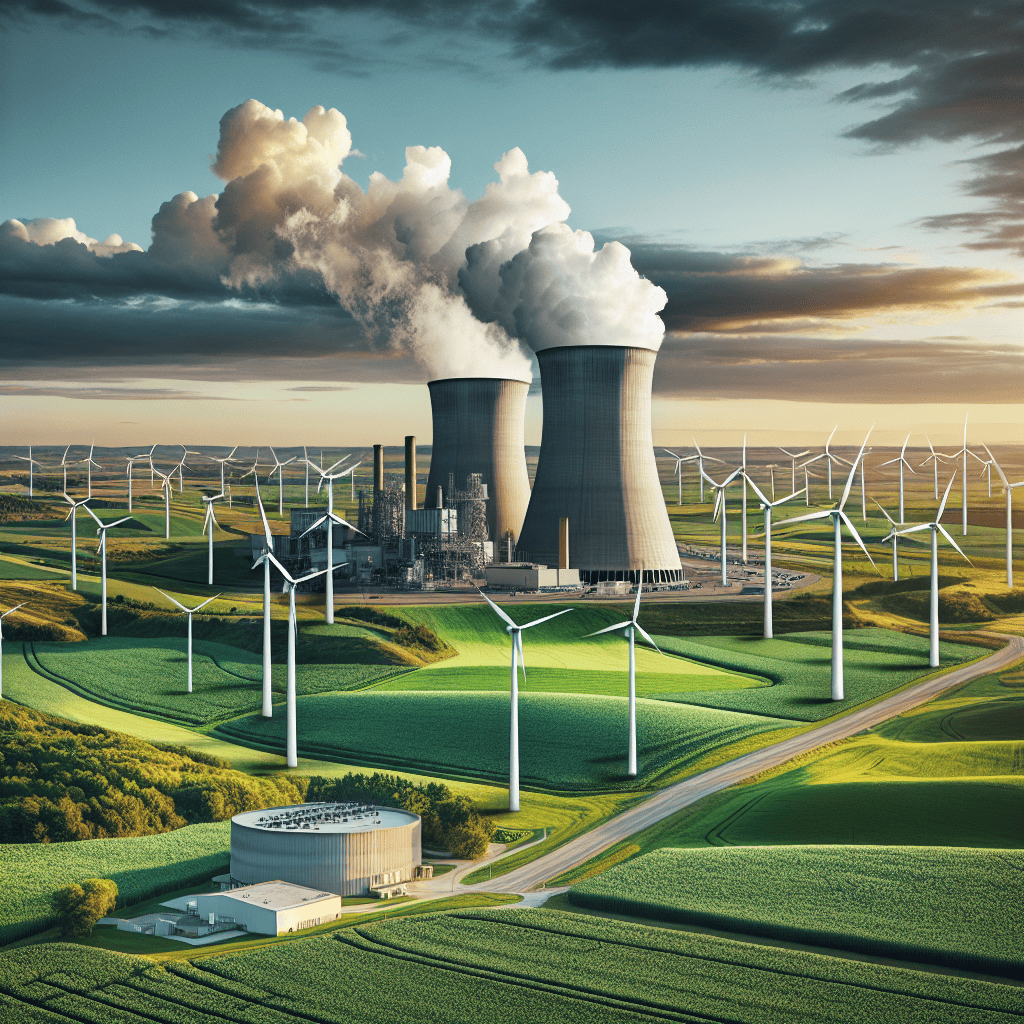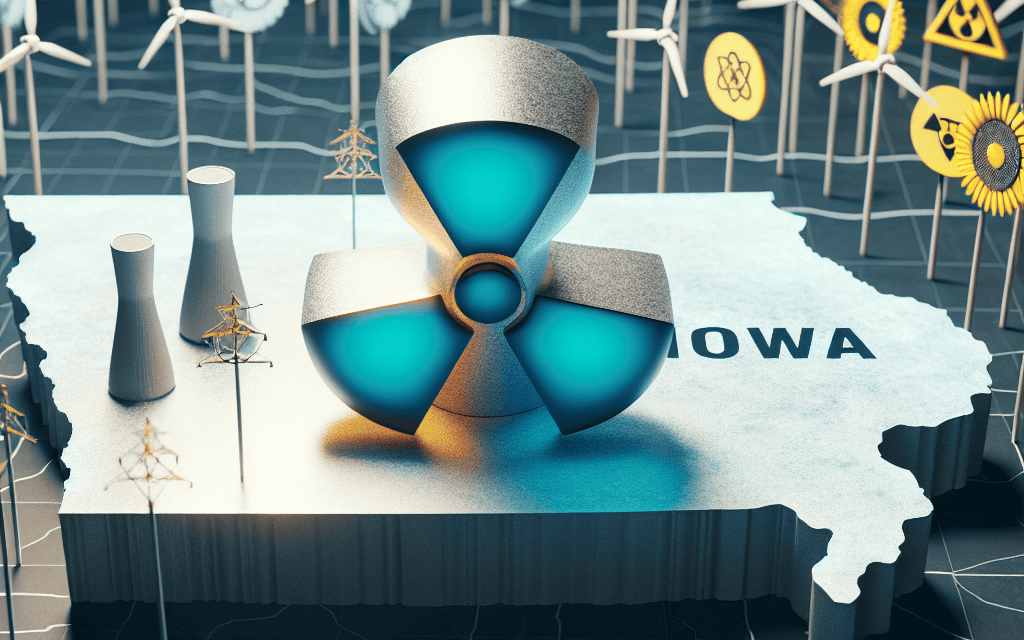“NextEra: Pioneering Iowa’s Energy Future with Nuclear Innovation and Renewable Synergy”
Introduction
NextEra Energy, a leading clean energy company, is exploring the revival of nuclear energy in Iowa as part of its broader strategy to enhance sustainable energy solutions. This initiative comes amid a surge in renewable energy agreements across the state, reflecting a growing commitment to diversify energy sources and reduce carbon emissions. By considering nuclear power, NextEra aims to complement Iowa’s existing renewable infrastructure, primarily dominated by wind and solar, with a reliable and low-carbon energy alternative. This move underscores the company’s dedication to innovation in energy production and its role in shaping a sustainable future for Iowa and beyond.
Iowa’s Nuclear Revival: NextEra’s Strategic Move
In recent years, the energy landscape in the United States has been undergoing a significant transformation, with a marked shift towards renewable energy sources. Amid this transition, NextEra Energy, a leading clean energy company, is exploring the potential revival of nuclear energy in Iowa, a state that has been at the forefront of renewable energy adoption. This strategic move comes as NextEra seeks to balance its growing portfolio of renewable energy agreements with the reliability and stability that nuclear power can provide.
Iowa has long been recognized for its commitment to renewable energy, particularly wind power, which has become a cornerstone of the state’s energy strategy. The state’s favorable wind conditions and supportive policy environment have attracted significant investments in wind energy infrastructure, making Iowa one of the leading states in wind energy production. However, as the demand for clean energy continues to rise, there is an increasing need to diversify energy sources to ensure a stable and reliable power supply. This is where NextEra’s interest in nuclear energy comes into play.
Nuclear energy, despite its controversial history, offers several advantages that complement renewable energy sources. It provides a consistent and reliable power output, which is crucial for maintaining grid stability, especially when renewable sources like wind and solar are intermittent. Furthermore, nuclear power plants have a low carbon footprint, aligning with the broader goals of reducing greenhouse gas emissions and combating climate change. By exploring the revival of nuclear energy in Iowa, NextEra aims to create a more balanced and resilient energy mix that can support the state’s growing energy needs.
NextEra’s exploration of nuclear energy in Iowa is not without its challenges. Public perception of nuclear energy remains mixed, with concerns about safety, waste management, and high costs often cited as significant barriers. To address these concerns, NextEra is likely to focus on advanced nuclear technologies that promise enhanced safety features and more efficient waste management solutions. These innovations could help alleviate public apprehensions and pave the way for broader acceptance of nuclear energy as a viable component of Iowa’s energy strategy.
Moreover, the regulatory landscape for nuclear energy is complex and requires careful navigation. NextEra will need to work closely with state and federal regulators to ensure compliance with stringent safety and environmental standards. This collaborative approach will be essential in gaining the necessary approvals and support for any potential nuclear projects in the state.
In parallel with its nuclear exploration, NextEra continues to expand its renewable energy agreements in Iowa. The company has been actively involved in developing wind and solar projects, contributing to the state’s impressive renewable energy capacity. By integrating nuclear energy into its portfolio, NextEra aims to enhance the reliability of its energy offerings while continuing to support Iowa’s renewable energy goals.
In conclusion, NextEra’s exploration of a nuclear revival in Iowa represents a strategic move to diversify and strengthen the state’s energy mix. By balancing the benefits of nuclear power with its growing renewable energy agreements, NextEra seeks to provide a stable, reliable, and sustainable energy future for Iowa. As the company navigates the challenges and opportunities associated with this endeavor, its efforts could serve as a model for other states looking to integrate diverse energy sources into their clean energy strategies.
Renewable Energy Agreements: NextEra’s Expanding Portfolio
NextEra Energy, a prominent player in the renewable energy sector, is making headlines with its exploration of reviving nuclear energy in Iowa, a move that comes amid its expanding portfolio of renewable energy agreements. This strategic consideration is part of NextEra’s broader vision to diversify its energy sources while maintaining a strong commitment to sustainability. As the company continues to forge new agreements in the renewable sector, the potential revival of nuclear energy in Iowa represents a significant development in its energy strategy.
The exploration of nuclear energy in Iowa is not an isolated endeavor but rather a calculated step in response to the growing demand for clean and reliable energy sources. Nuclear energy, known for its low carbon emissions and high energy output, presents a viable option for meeting the increasing energy needs while aligning with environmental goals. NextEra’s interest in this energy source is indicative of its forward-thinking approach, recognizing the potential of nuclear power to complement its existing renewable energy assets.
Simultaneously, NextEra is actively expanding its renewable energy agreements, a testament to its commitment to a sustainable future. The company has been at the forefront of renewable energy development, with a portfolio that includes wind, solar, and battery storage projects. These agreements not only enhance NextEra’s capacity to deliver clean energy but also reinforce its position as a leader in the transition to a low-carbon economy. By securing long-term contracts with various stakeholders, NextEra ensures a stable and predictable revenue stream, which is crucial for sustaining its ambitious growth plans.
Moreover, the expansion of renewable energy agreements is closely tied to the increasing emphasis on corporate sustainability and environmental responsibility. Businesses and governments alike are seeking partnerships with energy providers that can deliver on their sustainability commitments. NextEra’s ability to offer a diverse range of renewable solutions makes it an attractive partner for those looking to reduce their carbon footprint. This trend is expected to continue as more entities prioritize sustainability in their operations, further driving the demand for renewable energy agreements.
In addition to its renewable energy initiatives, NextEra’s exploration of nuclear energy in Iowa highlights the company’s adaptive strategy in navigating the evolving energy landscape. The potential revival of nuclear power in the state could serve as a model for integrating traditional and renewable energy sources, demonstrating how diverse energy portfolios can enhance grid reliability and resilience. This approach not only addresses current energy challenges but also positions NextEra to capitalize on future opportunities in the energy sector.
Furthermore, the integration of nuclear energy into NextEra’s portfolio could provide valuable insights into the role of nuclear power in achieving a balanced and sustainable energy mix. As the company evaluates the feasibility of this venture, it will likely consider factors such as technological advancements, regulatory frameworks, and public perception. These considerations are crucial in ensuring that any potential nuclear projects align with NextEra’s overarching sustainability goals and contribute positively to the energy transition.
In conclusion, NextEra’s exploration of nuclear energy in Iowa, alongside its expanding renewable energy agreements, underscores the company’s strategic vision for a sustainable energy future. By diversifying its energy sources and strengthening its renewable portfolio, NextEra is well-positioned to meet the growing demand for clean energy while maintaining its leadership in the industry. As the energy landscape continues to evolve, NextEra’s adaptive approach will likely serve as a blueprint for other companies navigating the complexities of the energy transition.
The Role of Nuclear Power in Iowa’s Energy Future
In recent years, the energy landscape in Iowa has been undergoing a significant transformation, driven by a growing commitment to renewable energy sources. As the state continues to expand its renewable energy agreements, NextEra Energy has emerged as a key player in exploring the potential revival of nuclear power as a complementary energy source. This exploration comes at a time when the need for reliable, low-carbon energy solutions is more pressing than ever, given the increasing demand for electricity and the urgent need to address climate change.
Iowa has long been a leader in renewable energy, particularly in wind power, which accounts for a substantial portion of the state’s energy mix. The state’s commitment to renewable energy is evident in its ambitious goals and the numerous agreements with renewable energy providers. However, as the state seeks to further reduce its carbon footprint and ensure a stable energy supply, the role of nuclear power is being reconsidered. Nuclear energy, known for its ability to provide a consistent and reliable power output, presents an attractive option for complementing intermittent renewable sources like wind and solar.
NextEra Energy, a prominent energy company with a strong track record in both renewable and nuclear energy, is at the forefront of this exploration. The company is evaluating the feasibility of introducing small modular reactors (SMRs) in Iowa, which represent a new generation of nuclear technology. SMRs offer several advantages over traditional nuclear reactors, including enhanced safety features, reduced construction times, and lower initial capital costs. These attributes make SMRs a potentially viable option for Iowa as it seeks to diversify its energy portfolio while maintaining its commitment to sustainability.
The integration of nuclear power into Iowa’s energy mix could provide several benefits. Firstly, it would enhance the reliability of the state’s energy supply by providing a stable base-load power source that is not subject to the variability of weather-dependent renewables. This stability is crucial for meeting the energy demands of both residential and industrial consumers, particularly during periods of low wind or solar output. Secondly, nuclear power’s low greenhouse gas emissions align with Iowa’s environmental goals, contributing to the reduction of the state’s overall carbon footprint.
However, the potential revival of nuclear power in Iowa is not without challenges. Public perception of nuclear energy remains a significant hurdle, with concerns about safety, waste management, and the high costs associated with nuclear projects. To address these concerns, NextEra Energy and other stakeholders must engage in transparent and informative dialogues with the public, highlighting the advancements in nuclear technology and the rigorous safety standards that govern its operation.
Moreover, regulatory and policy frameworks will play a crucial role in determining the feasibility of nuclear power in Iowa. Supportive policies that facilitate the development and integration of SMRs, along with incentives for clean energy investments, will be essential in overcoming the financial and logistical barriers associated with nuclear projects.
In conclusion, as Iowa continues to forge ahead with its renewable energy initiatives, the exploration of nuclear power by NextEra Energy represents a forward-thinking approach to achieving a balanced and sustainable energy future. By carefully considering the potential benefits and addressing the associated challenges, Iowa has the opportunity to set a precedent for other states seeking to integrate diverse energy sources in their pursuit of a low-carbon future.
NextEra’s Commitment to Sustainable Energy Solutions

NextEra Energy, a prominent player in the energy sector, has long been recognized for its commitment to sustainable energy solutions. As the world increasingly shifts towards renewable energy sources, NextEra has consistently positioned itself at the forefront of this transition. Recently, the company has turned its attention to Iowa, exploring the potential revival of nuclear energy in the state. This move comes amid a backdrop of growing renewable energy agreements, highlighting NextEra’s strategic approach to diversifying its energy portfolio while maintaining a focus on sustainability.
Iowa, known for its vast agricultural landscapes, has also been a leader in renewable energy, particularly wind power. The state’s commitment to clean energy has been evident in its substantial investments in wind farms, which have significantly contributed to its energy mix. However, as the demand for reliable and sustainable energy sources continues to rise, NextEra sees an opportunity to reintroduce nuclear energy as a complementary solution to Iowa’s existing renewable infrastructure. By doing so, the company aims to enhance the state’s energy resilience and reliability, ensuring a steady supply of clean energy even when wind and solar resources are less available.
The exploration of nuclear energy in Iowa is not without its challenges. Public perception of nuclear power has been shaped by historical events and concerns over safety and waste management. However, NextEra is committed to addressing these concerns through transparent communication and the implementation of advanced safety technologies. The company believes that modern nuclear reactors, with their enhanced safety features and reduced waste output, can play a crucial role in achieving a balanced and sustainable energy future.
In parallel with its nuclear exploration, NextEra continues to expand its renewable energy agreements across the United States. The company has been actively involved in developing large-scale solar and wind projects, further solidifying its position as a leader in the renewable energy sector. These projects not only contribute to reducing carbon emissions but also create economic opportunities in the form of jobs and local investments. By fostering partnerships with local communities and governments, NextEra ensures that its renewable initiatives align with regional energy goals and contribute to broader sustainability objectives.
The integration of nuclear energy into Iowa’s energy landscape represents a strategic move by NextEra to diversify its energy offerings while maintaining a strong commitment to sustainability. By combining nuclear power with existing renewable resources, the company aims to create a more robust and reliable energy system that can meet the growing demands of consumers and businesses alike. This approach underscores NextEra’s belief in a diversified energy portfolio as a means to achieve long-term sustainability and energy security.
As NextEra explores the potential of nuclear energy in Iowa, it remains steadfast in its mission to provide clean, reliable, and affordable energy solutions. The company’s efforts to balance innovation with environmental responsibility reflect its dedication to leading the energy transition. By embracing a mix of renewable and nuclear energy sources, NextEra is poised to play a pivotal role in shaping a sustainable energy future for Iowa and beyond. Through strategic investments and forward-thinking initiatives, the company continues to demonstrate its unwavering commitment to advancing sustainable energy solutions in an ever-evolving landscape.
Balancing Nuclear and Renewables: NextEra’s Approach
NextEra Energy, a prominent player in the energy sector, is exploring the potential revival of nuclear energy in Iowa, a state traditionally known for its robust agricultural economy and growing commitment to renewable energy sources. This exploration comes at a time when the company is also expanding its renewable energy agreements, reflecting a strategic approach to balance nuclear and renewable energy sources. As the global energy landscape shifts towards sustainability, NextEra’s dual focus on nuclear and renewables highlights the complexities and opportunities inherent in transitioning to a low-carbon future.
Nuclear energy, long considered a reliable and low-emission power source, has faced challenges in recent years due to high operational costs and public concerns over safety. However, its ability to provide a stable base load of electricity makes it an attractive option for complementing intermittent renewable sources like wind and solar. In Iowa, where wind energy has become a significant part of the energy mix, the integration of nuclear power could enhance grid stability and reliability. This potential revival of nuclear energy in Iowa is not merely about adding another power source; it is about creating a more resilient and balanced energy system that can meet the demands of a modern economy while reducing carbon emissions.
NextEra’s exploration into nuclear energy in Iowa is complemented by its ongoing efforts to expand renewable energy agreements. The company has been at the forefront of renewable energy development, with substantial investments in wind and solar projects across the United States. These investments are part of a broader strategy to increase the share of renewables in the energy mix, thereby reducing reliance on fossil fuels and contributing to climate change mitigation efforts. By pursuing both nuclear and renewable energy sources, NextEra is positioning itself as a leader in the transition to a sustainable energy future.
The integration of nuclear and renewable energy sources presents both challenges and opportunities. On one hand, the high initial costs and regulatory hurdles associated with nuclear energy can be daunting. On the other hand, the potential for nuclear power to provide a steady supply of electricity, regardless of weather conditions, makes it an appealing complement to renewables. This synergy between nuclear and renewables could lead to a more balanced and reliable energy system, capable of meeting the diverse needs of consumers and industries alike.
Moreover, NextEra’s approach underscores the importance of a diversified energy portfolio in achieving energy security and sustainability. By investing in both nuclear and renewable energy, the company is not only hedging against the volatility of energy markets but also ensuring that it can meet future energy demands in an environmentally responsible manner. This balanced approach is crucial as the world grapples with the dual challenges of energy security and climate change.
In conclusion, NextEra’s exploration of nuclear energy in Iowa, alongside its expanding renewable energy agreements, represents a strategic effort to balance the benefits and challenges of different energy sources. By integrating nuclear and renewables, NextEra is paving the way for a more resilient and sustainable energy future. This approach not only aligns with global efforts to reduce carbon emissions but also ensures that the energy needs of future generations can be met in a reliable and sustainable manner. As the energy landscape continues to evolve, NextEra’s balanced approach serves as a model for other energy companies seeking to navigate the complexities of the transition to a low-carbon economy.
Economic Impacts of NextEra’s Nuclear Initiatives in Iowa
NextEra Energy’s exploration of reviving nuclear energy in Iowa comes at a pivotal moment, as the state continues to expand its renewable energy agreements. This initiative could have significant economic impacts, both locally and beyond. As Iowa is already a leader in wind energy, the introduction of nuclear power could diversify the state’s energy portfolio, potentially stabilizing energy prices and creating new economic opportunities. The economic implications of such a move are multifaceted, involving job creation, infrastructure development, and potential shifts in energy market dynamics.
Firstly, the revival of nuclear energy in Iowa could lead to substantial job creation. The construction and operation of nuclear facilities require a highly skilled workforce, which could result in the creation of numerous high-paying jobs. These positions would not only include direct employment at the nuclear plants but also extend to ancillary industries such as construction, engineering, and maintenance. Moreover, the presence of a nuclear facility could stimulate local economies by increasing demand for goods and services, thereby benefiting businesses in the surrounding areas.
In addition to job creation, the development of nuclear energy infrastructure could have a significant economic impact. Building a nuclear power plant is a capital-intensive endeavor, necessitating substantial investment in technology, materials, and labor. This investment could lead to the growth of local industries and attract further investment from other sectors. Furthermore, the establishment of a nuclear facility could enhance Iowa’s energy infrastructure, making it more resilient and capable of meeting future energy demands. This could be particularly beneficial as the state continues to expand its renewable energy agreements, ensuring a stable and reliable energy supply.
Moreover, the introduction of nuclear energy could influence energy market dynamics in Iowa. By diversifying the state’s energy sources, nuclear power could help stabilize energy prices, which can be volatile due to fluctuations in supply and demand. A more stable energy market could attract businesses looking for reliable and affordable energy, potentially leading to increased economic activity and growth. Additionally, nuclear energy’s low carbon footprint aligns with global efforts to reduce greenhouse gas emissions, which could enhance Iowa’s reputation as a leader in sustainable energy practices.
However, it is essential to consider the potential challenges and risks associated with nuclear energy. Public perception of nuclear power can be a significant hurdle, as concerns about safety and environmental impact persist. Addressing these concerns through transparent communication and robust safety measures will be crucial to gaining public support and ensuring the success of NextEra’s nuclear initiatives. Furthermore, the long-term management of nuclear waste remains a critical issue that must be addressed to ensure the sustainability of nuclear energy.
In conclusion, NextEra’s exploration of nuclear energy in Iowa presents a unique opportunity to enhance the state’s energy landscape and stimulate economic growth. By creating jobs, developing infrastructure, and stabilizing energy markets, the revival of nuclear power could have far-reaching economic impacts. However, careful consideration of the associated challenges and risks will be essential to realizing these benefits. As Iowa continues to lead in renewable energy, the integration of nuclear power could position the state as a pioneer in sustainable and diversified energy solutions, ultimately contributing to a more resilient and prosperous economy.
Public Perception and Policy Challenges in Iowa’s Nuclear Revival
As NextEra Energy explores the potential revival of nuclear energy in Iowa, the public perception and policy challenges surrounding this initiative have become focal points of discussion. The state, known for its vast cornfields and wind turbines, has long been a leader in renewable energy, particularly wind power. However, the introduction of nuclear energy into this landscape presents a complex array of challenges and opportunities that require careful consideration.
Public perception of nuclear energy in Iowa is shaped by a combination of historical context, environmental concerns, and economic factors. Historically, nuclear energy has been met with skepticism due to high-profile incidents such as the Three Mile Island accident and the Fukushima disaster. These events have left a lasting impression on the public, fostering a sense of caution and wariness. In Iowa, where renewable energy sources like wind and solar have been embraced for their perceived safety and environmental benefits, nuclear energy must overcome significant public relations hurdles to gain widespread acceptance.
Moreover, environmental concerns play a crucial role in shaping public opinion. While nuclear energy is often touted as a low-carbon alternative to fossil fuels, the issue of radioactive waste disposal remains a contentious topic. The long-term storage and management of nuclear waste pose significant environmental and safety challenges that must be addressed to alleviate public fears. In a state that prides itself on its commitment to sustainability, any proposal to introduce nuclear energy must convincingly demonstrate its environmental viability.
Economic considerations also influence public perception. Proponents of nuclear energy argue that it can provide a stable and reliable source of power, complementing the intermittent nature of wind and solar energy. This reliability is particularly appealing as Iowa continues to expand its renewable energy agreements, necessitating a dependable energy backbone. However, the high initial costs associated with building and maintaining nuclear facilities can be a deterrent. The public must be assured that the economic benefits, such as job creation and energy security, outweigh these costs.
Transitioning from public perception to policy challenges, it is evident that regulatory frameworks play a pivotal role in determining the feasibility of nuclear energy projects. In Iowa, as in many other states, the regulatory landscape is primarily geared towards supporting renewable energy initiatives. Adapting these frameworks to accommodate nuclear energy requires a delicate balance between encouraging innovation and ensuring public safety. Policymakers must navigate a complex web of federal and state regulations, addressing issues such as licensing, safety standards, and waste management.
Furthermore, political dynamics can significantly impact the policy environment. In Iowa, where agriculture and renewable energy are deeply intertwined with the state’s identity, any shift towards nuclear energy must be carefully negotiated. Policymakers must engage with a diverse array of stakeholders, including environmental groups, industry leaders, and local communities, to build consensus and foster collaboration. This requires transparent communication and a commitment to addressing the concerns of all parties involved.
In conclusion, as NextEra Energy explores the potential revival of nuclear energy in Iowa, it must contend with a multifaceted landscape of public perception and policy challenges. Overcoming historical skepticism, addressing environmental concerns, and demonstrating economic viability are essential steps in gaining public support. Simultaneously, navigating the regulatory and political complexities requires a strategic and inclusive approach. By addressing these challenges head-on, Iowa has the opportunity to pioneer a balanced energy future that integrates nuclear power with its existing renewable energy strengths.
Q&A
1. **What is NextEra’s recent initiative in Iowa?**
NextEra is exploring the revival of nuclear energy in Iowa as part of its energy strategy.
2. **Why is NextEra considering nuclear energy in Iowa?**
NextEra is considering nuclear energy to complement its growing portfolio of renewable energy sources and to provide a stable, carbon-free energy supply.
3. **What are the potential benefits of nuclear energy for Iowa?**
Nuclear energy could provide a reliable and consistent power source, reduce carbon emissions, and support the state’s energy needs alongside renewables.
4. **How does nuclear energy fit into NextEra’s overall strategy?**
Nuclear energy is seen as a way to diversify NextEra’s energy mix, ensuring reliability and sustainability while meeting environmental goals.
5. **What challenges might NextEra face in reviving nuclear energy in Iowa?**
Challenges include regulatory hurdles, public perception, high initial costs, and the long timeline for development and construction.
6. **What role do renewable energy agreements play in NextEra’s plans?**
Renewable energy agreements are crucial for expanding NextEra’s clean energy footprint and are part of a broader strategy to integrate various energy sources.
7. **How might NextEra’s nuclear initiative impact the local economy in Iowa?**
The initiative could create jobs, stimulate local economic growth, and position Iowa as a leader in clean energy innovation.
Conclusion
NextEra Energy’s exploration of reviving nuclear energy in Iowa, amidst its growing renewable energy agreements, highlights a strategic diversification in its energy portfolio. This move underscores the company’s commitment to balancing sustainable energy production with reliable baseload power, addressing both environmental concerns and energy demands. By potentially integrating nuclear power, NextEra aims to enhance grid stability and reduce carbon emissions, complementing its existing investments in wind and solar energy. This approach not only positions NextEra as a leader in the transition to cleaner energy but also reflects a broader industry trend of revisiting nuclear energy as a viable component of a sustainable energy future.





